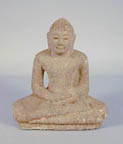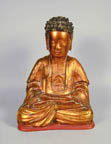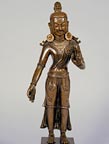Teacher Resources
Buddhist Places
Suggested Grade Level: Grade
10, World History, Culture, and Geography—The Modern World
; Grade 12, Principles of American Democracy
Subject: Social Studies, History
Estimated Time: Up to 1 week
  
Seated Buddha
Sri Lanka, 12th century
Stone
Pacific Asia Museum Collection
Gift of Mark Phillips and Iuliana Phillips, 2001.56.62
Seated Buddha
Vietnam, 19th century
Lacquered wood
Pacific Asia Museum Collection
Museum Purchase with funds from the Bressler Foundation, 1996.28.2
Maitreya, the Buddha
of the Future
Tibet, early 14th century
Silver with traces of gilding
Pacific Asia Museum Collection
Gift from the Nancy King Collection, 2001.1.1
Introduction
Many
of us in the West consider Buddhism to be one of the most peaceful
of the world religions. After all, the Buddha spoke of the wisdom
of the Middle Path, which counsels believers to act and speak rightly,
without clashing with others. And yet, in the 20th and 21st centuries,
nations in which a significant portion of the population practice
Buddhism have been torn by conflict. Often global political conflicts
have affected an entire region; in other nations, ethnic tensions
have led to bloodshed and violence.
These artworks provide an entry point for
students to research and present their ideas and findings about
strains shaping regions where men and women practicing Buddhism
have had a significant role in shaping their countries’ histories.
Lesson Objectives
1. Understand basic tenets of Buddhism as they relate to the practitioner’s
daily, social and political life
2. Gain specific content knowledge of ongoing political events within
Southeast and Central Asia
3. Hone library and internet research skills.
Instructional Materials
Activity and Discussion
The three artworks above--from Sri Lanka, Vietnam, and Tibet—all
represent nations that have had significant events take place that
relate to their Buddhist populations. Students should use historical
analysis or literary devices such as haiku to reflect on the way
these artworks connect to the events they are exploring. Ask students
to form groups to research and present their findings on:
1. Present-day conflict between the Buddhist
Sinhalese and Hindu Tamils in Sri Lanka. What is the history of
Buddhism in Sri Lanka? Of Hinduism? What role does Buddhism play
in Sinhala nationalism? Do students, based on their research, have
recommendations for resolving the conflict?
2. In 1963, a Buddhist monk burned himself
to death in Saigon (now Ho Chi Minh City) to protest the Catholic
government’s banning of Buddhist celebrations. His act brought
world attention to Vietnam and the role of the U.S. government in
supporting what some saw as a corrupt regime. What were the issues
surrounding the monk’s protest? How did his action mesh with
Buddhist beliefs? What is the history of Buddhism in Vietnam and
what role does it play today?
3. Before the 1950s, Tibet was an independent
nation isolated from the rest of the world. What happened to change
Tibet’s isolation? What role has a Buddhist leader played
in keeping these events in front of the eye of the world?
4. In spring 2001, the government of Afghanistan
destroyed the monumental Buddhist statues carved hundreds of years
ago. What is the history of Buddhism in Afghanistan? What is the
history of the statues of Buddha in Bamiyan? Debate: should the
statues be rebuilt?
Standards
California State Educational Standards:
Grade 10
10.9 Students analyze the international developments in the post-World
War II world, in terms of:
2. the causes of the Cold War, with the free
world on one side and Soviet client states on the other, including
competition for influence in such places as Egypt, the Congo, Vietnam,
and Chile
4. the Chinese Civil War,
the rise of Mao Tse-tung, and the subsequent political and economic
upheavals in China (e.g., the Great Leap Forward, the Cultural Revolution,
and the Tiananmen Square uprising)
10.10 Students analyze instances of nation-building
in the contemporary world in two of the following regions or countries:
the Middle East, Africa, Mexico and other parts
of Latin America, or China, in terms of:
4. challenges in the region, including its
geopolitical, cultural, military, and economic significance and
the international relationships in which it is involved the recent
history of the region, including the political divisions and systems,
key leaders, religious issues, natural features, resources, and
population patterns the important trends in the region today and
whether they appear to serve the cause of individual freedom and
democracy
Students in grade ten study major turning
points that shaped the modern world, from the late 18th century
through the present, including the cause and course of the two world
wars. They trace the rise of democratic ideas and develop an understanding
of the historical roots of current world issues, especially as they
pertain to international relations. They extrapolate from the American
experience that democratic ideals are often achieved at a high price,
remain vulnerable and are not practiced everywhere in the world.
Students develop an understanding of current world issues and relate
them to their historical, geographic, political, economic, and cultural
contexts. Students consider multiple accounts of events in order
to understand international relations from a variety of perspectives.
12.9 Students analyze the origins, characteristics,
and development of different political systems
across time, with emphasis on the quest for political democracy,
its advances and obstacles, in terms of:
4. the consequences of conditions that gave
rise to tyrannies during certain periods applied to at least two
countries (e.g., Italy, Japan, Haiti, Nigeria,
Cambodia)
5. the forms of illegitimate power that twentieth
century African, Asian, and Latin American dictators
used to gain and hold office and the conditions and interests that
supported them
8. the successes of relatively new democracies
in Africa, Asia and Latin America and the ideas,
leaders, and general societal conditions that have launched and
sustained or failed to sustain them

|
![]()